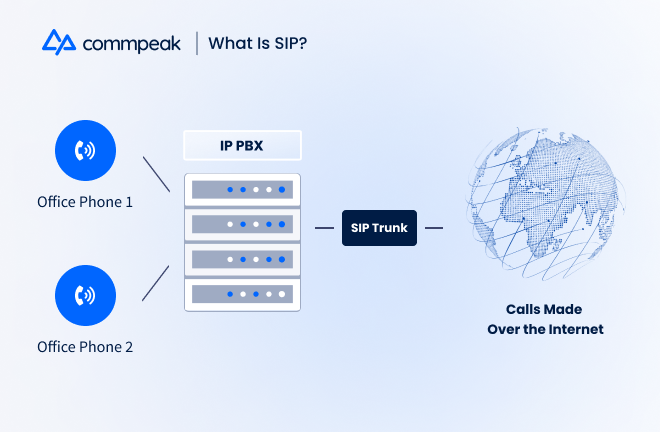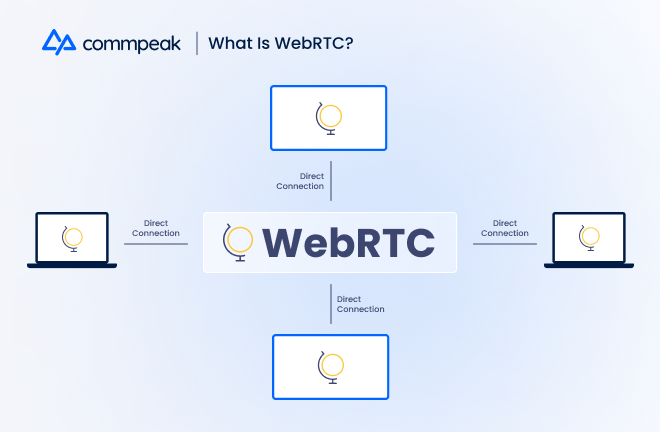Compared to the old days when setting up bulk desk phones would waste considerable time, configuring a business phone system today is virtually painless. Once the paperwork is signed, your agents only need to log into a web-based platform courtesy of the cloud VoIP provider your business employs. However, choosing your business’s telecom vendor can be more complex than the setup process.
For small and mid-sized business owners, it’s critical to consider pricing, scalability, and usability first. As a part of this buying process, one of the essential questions to answer is whether to adopt SIP or WebRTC for your real-time communications infrastructure. These technologies provide unique benefits and drawbacks that will affect your operations.
While SIP and WebRTC are similar in that they both facilitate real-time collaboration with essential parties, like customers, colleagues, and potential partners. The caveat is that these technologies work very differently, influencing how you set up and ultimately maintain your communication system.
What Is SIP?
SIP stands for Session Initiation Protocol. In its simplest form, SIP is a protocol, or a set of rules, that establishes communication by setting up a session between two or more servers, managing the signal throughout the conversation, and, finally, terminating the connection once the session ends. It’s a technology that emerged in the 1990s and eventually resulted in VoIP (Voice over Internet Protocol) technology.
SIP, or SIP trunking, can facilitate real-time connections with any internet-connected device (even legacy hard phones!). The main advantage of this protocol, of course, is that your business isn’t burdened by a traditional phone system’s operational costs and infrastructure demands.

What Are the Benefits of SIP Trunking?
Plenty of businesses have harnessed the power of SIP trunking for good reasons. It can be very beneficial under the right circumstances. How?
- It combines your voice and data for a single bill.
- Both office and remote workers can use a single network.
- It’s scalable as needed, whether adding users or more bandwidth.
- SIP trunking consolidates internal and external communications into a unified system.
- Businesses use it to manage different channels like voice, chat, and video conferencing within a single platform.
- Vendors charge you lower, more cost-effective local rates for long-distance and international calls.
- SIP enables you to set up local area codes with your company’s phone number.
It’s important to keep in mind that your company will need specialized equipment, software, and a strong internet connection to utilize SIP-based VoIP calls and video conferencing. Alternatively, you can opt for SIP trunking services. SIP trunking providers offer virtual phone lines that harness your existing connection to deliver high-quality voice connections. Indeed, you have a few options if you plan to use this handy protocol for communication.
To learn more about whether SIP-based connectivity is right for your business, contact our sales team today.
What Is WebRTC?
The other method of equipping your employees with real-time communication capabilities is to leverage WebRTC. This free, open-source API (application programming interface) technology allows web browsers to access built-in and external devices like microphones and cameras.
Google introduced WebRTC over a decade ago, in 2011, and it quickly became a popular alternative to SIP turning. WebRTC empowers businesses to use voice and video communication directly inside their web pages. It’s similarly unitable with internal business applications without a browser. The simple integration process makes it easier for companies to implement a means through which customers can quickly get in touch.
If you’ve ever used Google Meet or Zoom, then you’ve experienced the power of WebRTC. Unlike SIP, you don’t need to purchase supported equipment or software. In fact, any browser-enabled device, such as smartphones and tablets, can use this technology. Many businesses use it today because it’s inexpensive and highly flexible to meet their needs.
For a brief but more in-depth understanding of this handy connectivity method, check out WebRTC 101!

What Are the Benefits of WebRTC?
In addition to the advantage mentioned above, there are several more upsides of implementing WebRTC into your browser or application.
- Developers can implement it rapidly using the standardized API.
- Businesses can send various types of data easily, including audio, video, text, images, and other types of files.
- It’s open-source, which means it’s absolutely free to take and use on your personal website or application.
- The technology is updated frequently thanks to browser updates and developer initiatives.
- There are more real-time data-sharing possibilities, such as virtual events and online gaming.
- WebRTC is an adaptive network solution that adjusts automatically according to connection quality and bandwidth.
- There’s “always-on” voice and video encryption, protecting your privacy from unwanted hackers.
Although WebRTC is more than 10 years old, it’s relatively young compared to SIP, so it’s not compatible with analog legacy technologies or hardware. Moreover, applications that use WebRTC take up much more memory than SIP, causing problems for older, slower devices.
WebRTC vs. SIP: What’s Better?
Choosing the right technology for your business and employees entirely depends on your current setup and future needs. As with all decisions, there will inevitably be both advantages and shortcomings.
You can leverage SIP trunking if you want to continue using your legacy technology, such as desk phones and internal PBX (private branch exchange) systems. There’s no reason to get rid of your current infrastructure if it’s working for you! SIP services also allow you to access the cloud and integrate your existing operations with digital channels. So if you have already invested in SIP, it’s not necessary to integrate WebRTC.
WebRTC is practical for newer businesses starting to build themselves from the ground up. It’s especially helpful if your staff mainly communicates on digital channels with modern devices. Applications that leverage WebRTC are easier to scale and use, making them ideal for smaller companies with limited resources.
The best news is that your choice doesn’t have to be “either-or.” Companies that have existing SIP-supported systems can also use WebRTC for digital applications. For instance, you can embed Click-to-Call directly on your website or app so customers can call you from their browser.
The Final Verdict
Unfortunately, without knowing more in-depth details about your communication needs, it would be difficult and unwise to offer you a final appraisal about which protocol is best suited for your business. However, as you have read, both provide a specific set of benefits that will boost your customers’ abilities to connect with you, which is most important.
Thankfully, CommPeak offers solutions that are compatible with SIP and WebRTC, such as our VoIP Service and free WebRTC Softphone. So, no matter which you choose, CommPeak will be there to set you up for success.
Contact us today and implement the system that works best for you.


